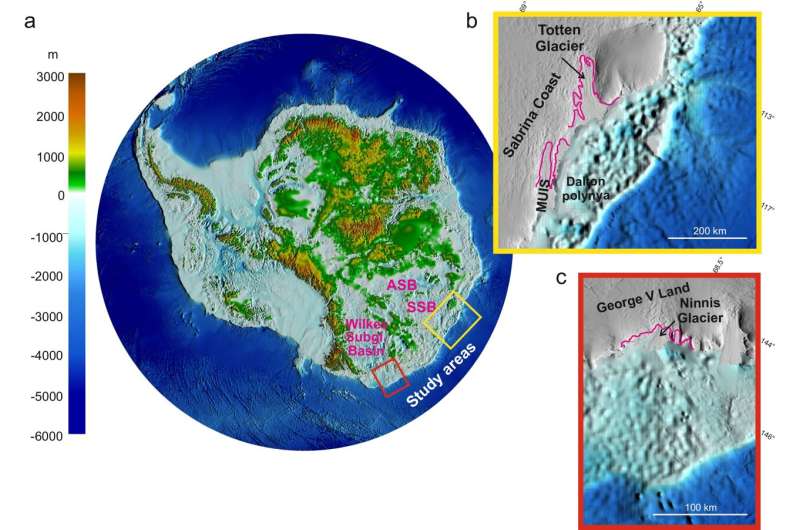This article has been reviewed according to Science X's editorial process and policies. Editors have highlighted the following attributes while ensuring the content's credibility:
fact-checked
peer-reviewed publication
trusted source
proofread
Submarine canyons are crucial for the instability of the Antarctic ice sheet, suggests study

Antarctic canyons play a crucial role in the instability of the East Antarctic Ice Sheet, as they facilitate the transfer of relatively warm water (Circumpolar Deep Water) from the abyssal areas to the continental shelf and from there to the base of the ice sheet, thus contributing to its melting.
A study, conducted by an international team of researchers led by the National Institute of Oceanography and Applied Geophysics (OGS) and including the University of Southampton, highlights the discovery of sedimentary bodies within the main canyon systems that represent the geological footprint of persistent bottom currents flowing along the canyons and carrying the ocean's heat to the Antarctic continent.
The study is published in Nature Communications.
"The intrusion of relatively warm water onto the continental shelf is widely recognized as a threat to the Antarctic ice sheet," comments Federica Donda, marine geologist in the OGS Geophysics Department and the lead author of the article. "Constraining the extent and long-term persistence of this phenomenon is fundamental to analyze the potential responses of the ice sheet to global warming."
The work focused on the Totten and Ninnis glaciers, which lie at the mouth of the two most important subglacial features in East Antarctica: Aurora-Sabrina and Wilkes sub-glacial basins.
"The analysis of geophysical and oceanographic data collected during an Italian-Australian multidisciplinary cruise led to the discovery of dome-shaped sedimentary bodies (sediment drifts) several thousand meters wide and 40 to 80 meters thick, whose internal and external characteristics indicate that they were formed by bottom currents directed towards the continental shelf," Donda continues.
"This is confirmed by oceanographic data obtained in one of the canyons off Totten Glacier, which recorded currents of about 10 cm/s near the seafloor, at a depth of about 3,500 meters. These currents are associated with an oceanic circulation characterized by the presence of large cyclonic eddies that transport different water masses, including the warm waters of the Circumpolar Deep Water.
"The southward component of these eddies is conveyed through the canyons, which locally have a relief of more than 700 meters and are therefore the preferred routes for the transfer of such water masses toward the continent. The thickness of the sedimentary bodies identified within the canyons indicates that oceanic heat transfer has continued for at least the last million years."
"Until a few years ago we thought that the East Antarctic Ice Sheet was stable," adds Dr. Alessandro Silvano, from the University of Southampton.
"Today we know not only that some East Antarctic glaciers are melting, but thanks to this work, we have also discovered that there are preferential ways for warm waters to reach persistently two of the largest glaciers on Earth and melt them from below."
The East Antarctic ice sheet is attracting increasing attention in the scientific world because its melting, even if only partial, could contribute significantly to sea level rise. Indeed, the Aurora-Sabrina and Wilkes sub-glacial basins hold the equivalent of over 8 meters of global mean sea level rise.
The results of this study emphasize the key role of submarine canyons, which are therefore key areas for understanding the mechanisms associated with the melting of the ice sheet in the past and present, thus contributing to the formulation of predictions of future sea level rise.
The research activity involved the National Institute of Oceanography and Applied Geophysics—OGS, the University of Southampton, Rutgers, the State University of New Jersey, Colgate University, Geoscience Australia, the All-Russia Scientific Research Institute for Geology and Mineral Resources of the Ocean, the St. Petersburg State University, the University of Tasmania and Macquarie University.
More information: Federica Donda et al, Footprint of sustained poleward warm water flow within East Antarctic submarine canyons, Nature Communications (2024). DOI: 10.1038/s41467-024-50160-z
Journal information: Nature Communications
Provided by University of Southampton



















